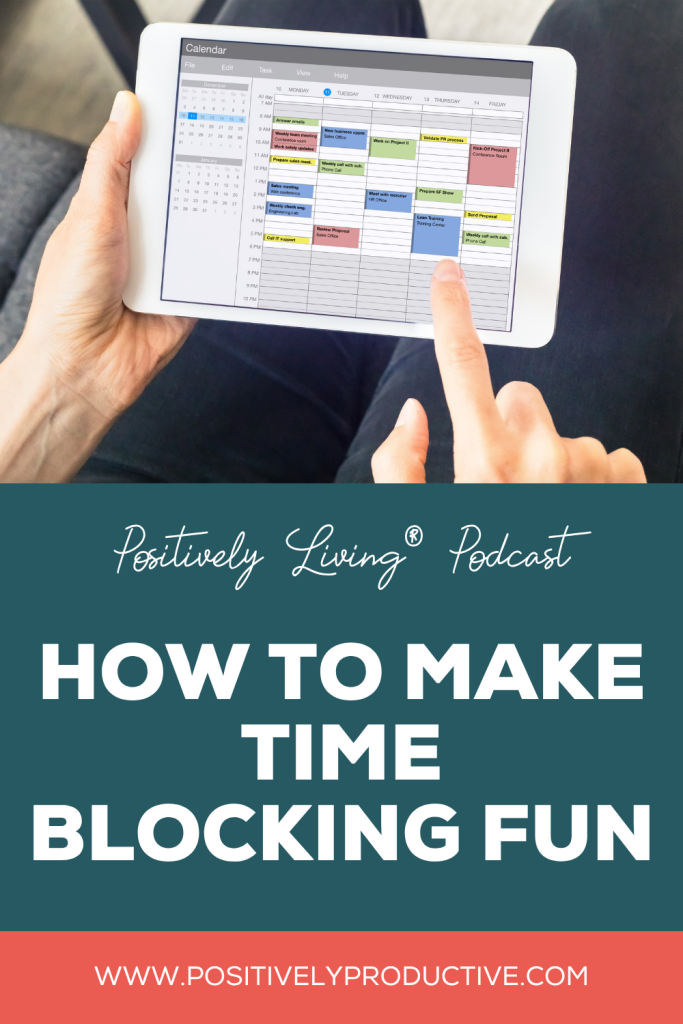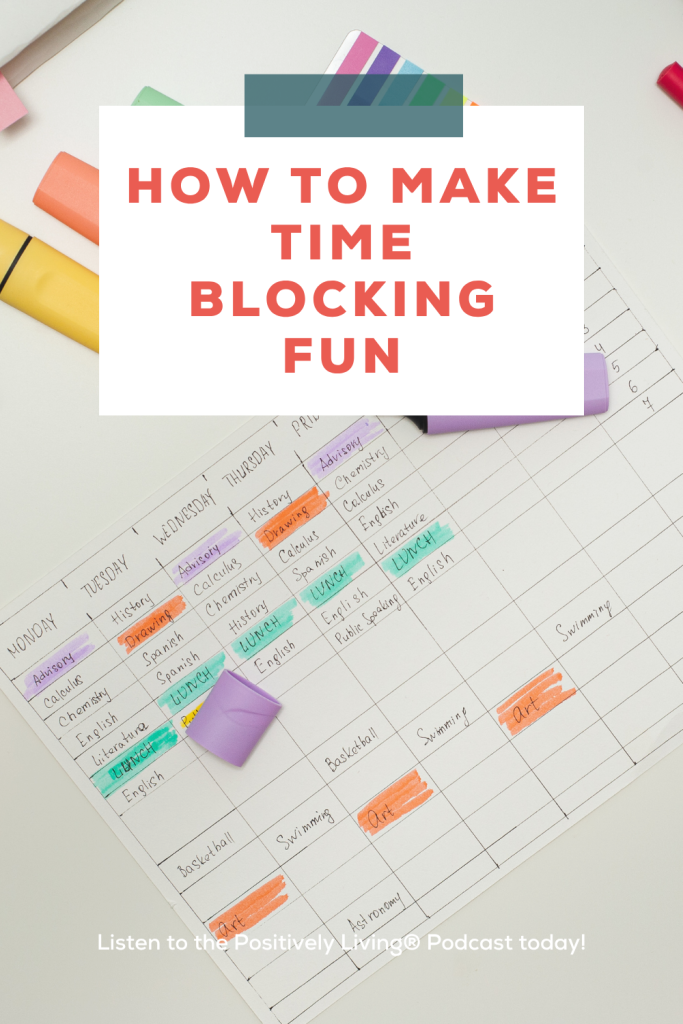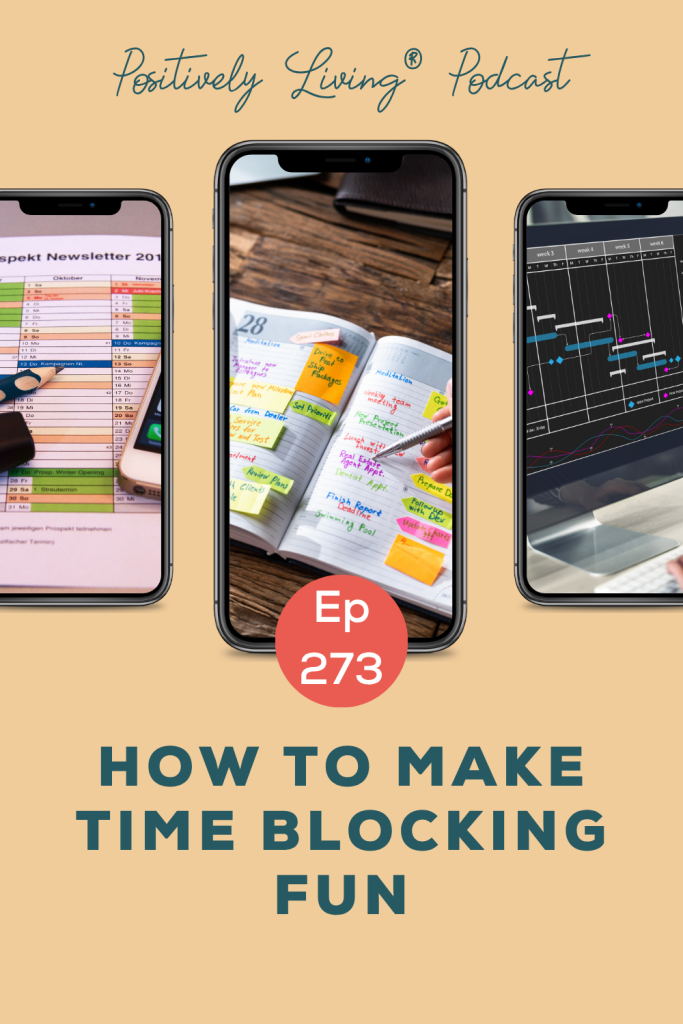Have you ever tried traditional time blocking only to find it too rigid, frustrating, or just plain boring? The one-size-fits-all approach to productivity often ignores the realities of our busy, unpredictable lives, leading to guilt and a feeling of failure when things don’t go according to plan. What if you could design a time management system that is not only effective but also fun, flexible, and perfectly suited to your unique brain?
In this episode of the Positively LivingⓇ Podcast, I show you how to move past the traditional, rigid idea of time blocking and create a personalized, compassionate approach I call “flex blocking”. You will discover how adding play and personality to your schedule can help you overcome resistance and achieve your goals without the frustration.
I cover the following topics:
- Why traditional time blocking can feel frustrating and rigid, especially for those with high demands or low energy.
- The benefits of time blocking, such as reducing decision fatigue and creating boundaries for your time.
- How “flex blocking” uses fun, personalized themes and categories to make your schedule feel more like a game than a chore.
- Why this approach works so well with our brains, which are wired for pattern recognition and story.
- Practical steps for getting started, including how to review your week and use color coding to visualize your balance.
Ready to plan your days your way? Find a time blocking system that is fun, flexible, and truly functional for your life.
The Flexible Guide to Time Blocking: Make Your Schedule Fun and Functional
Have you ever tried time blocking only to find it too rigid, frustrating, or just plain boring? It’s a common problem. We are often taught that productivity means following a strict, one-size-fits-all schedule, but what happens when life gets messy? When your energy is low, or your plans get derailed, that rigid schedule brings along guilt and a feeling of failure. What if there was a way to get all the benefits of time blocking without the punishment? What if your schedule could be a flexible, creative playground instead of a restrictive to-do list?
This article is for anyone who has struggled to stick to a schedule, feels overwhelmed by a lack of structure, or simply wants a more compassionate way to manage their time. You will discover how to create a time blocking system that is fun, flexible, and perfectly designed for your unique brain and life. Get ready to turn your calendar into a powerful tool for freedom and success.
The Problem with Rigid Time Blocking
The biggest challenge with traditional time blocking is that it is often presented as a rigid and inflexible technique. It tells you to do a specific thing at a specific time, every day, which discounts the reality of our lives. This approach can be especially frustrating for those with high demands, like caregivers, or for people with low energy. When a schedule is too strict, you are not building in flexibility; you are just forced to be flexible when things go wrong, which often comes with a dose of shame and guilt. This is the difference between being proactive and reactive in your day.
Traditional time blocking can feel like a rigid set of rules that discounts your real-life challenges. A better approach gives you the benefits of time blocking—like reducing decision fatigue, protecting your time, and batching tasks—while still allowing for the chaos and flow of a real, human life.
Quick Wins & Key Takeaways:
- Rigid schedules often fail because they ignore real-life demands and energy levels.
- This approach can lead to feelings of guilt and shame when things do not go as planned.
- Time blocking helps you reduce decision fatigue and protect your time.
- The solution is a flexible approach that allows for proactive adjustments, not reactive scrambling.
Step 1: Speak Your Brain’s Language with Fun Naming
Our brains are wired to respond to stories and patterns, and they are quick to avoid anything they perceive as boring. So, when your schedule is filled with blocks named “administrative tasks” or “client calls,” your brain might just put up a wall of resistance. The mistake is thinking that your schedule has to be all business.
The secret is to make your calendar a playground for your brain. You can do this by giving your time blocks fun, playful names that you actually like. This simple act taps into your brain’s reward system, which helps reinforce habits and reduces internal resistance. When a block of time has a name that makes you smile, you are more likely to follow through on taking action. This strategy works especially well for people who naturally resist structure.
Quick Wins & Key Takeaways:
- Your brain avoids things it perceives as boring or difficult.
- Name your time blocks with playful, meaningful names.
- Fun names tap into your brain’s reward system and reduce resistance.
- A fun approach is more likely to help you follow through and take action.
- This strategy is great for people who resist traditional scheduling.
Step 2: Group Tasks with Flexible Theming
Instead of just grouping tasks by function (e.g., all chores together), consider theming your time blocks in a way that aligns with your energy and unique needs. The mistake is to think that all tasks of a similar type must be batched together, which can be exhausting if your energy is not up to it.
Theming your time blocks can be based on energy levels, such as “low focus tasks” for when you feel drained, or “deep work” for when your mind is sharp. You can give these themes fun names that help you remember the purpose of the block. For example, “Mission Monday” could be for business goals, while “Low and Slow” could be for a day when you have low energy. This approach works beautifully for people who need a sense of internal logic and purpose for their work. By theming your schedule, you are building in flexibility so you can swap blocks around without guilt.
Quick Wins & Key Takeaways:
- Theme your time blocks based on energy levels (e.g., low-focus vs. high-focus).
- Give your themes names that speak to you and help you remember their purpose.
- Flex blocking works well for people who need internal logic and a sense of purpose to act.
- Create blocks that are modular, so you can move them around proactively, without guilt.
- This strategy allows you to get things done at a pace that works for you.
Step 3: Color-Code for a Quick Visual Check-in
A calendar filled with black text can feel overwhelming. You have to read each item to know what is on your plate and if your week is balanced. The mistake is not using visual cues that allow you to quickly understand your schedule and your priorities.
Color-coding your calendar is a simple but powerful way to get a quick visual check-in. You can assign different colors to different types of activities, like red for high-focus work, blue for low-energy tasks, or yellow for creative or self-care time. This not only gives you permission to go with your energy flow each day but also provides a simple reminder of your balance. For example, if you see you do not have enough of your self-care color, you know you need to schedule more of it.
Quick Wins & Key Takeaways:
- Use color coding to get a quick visual overview of your week.
- Assign colors to different activity types or energy levels.
- Color coding gives you permission to flow with your energy each day.
- It helps you quickly spot if your week has a healthy balance of work and rest.
Your Guide to Fun, Flexible Planning
Time blocking does not have to be a rigid, boring system that sets you up for failure. When you make it fun and flexible by adding your personality and honoring your natural rhythms, you increase your chances of success. It is about creating a schedule that works with you, not against you. The magic of “flex blocking” is that it lets you plan your days your way, with a compassionate, guilt-free approach.
Here is your action plan to start flexible time blocking:
- Review your week: Take a few moments to think about what roles you play, what needs attention, and what you want more of in your life.
- Theme your time blocks: Group tasks into categories based on function or energy levels and give them fun, personal names.
- Use color coding: Assign a color to each theme to get a simple visual reminder of your balance.
- Schedule self-care: Create specific blocks for resting and recharging, making them a priority, not an afterthought.
If you have tried time blocking before and it did not work, I encourage you to try it again. Make it fun, make it flexible, and make it your own.
Thank you for listening! If you enjoyed this episode, take a screenshot of the episode to post in your stories and tag me! And don’t forget to follow, rate, and review the podcast and tell me your key takeaways!
Learn more about Positively LivingⓇ and Lisa at https://positivelyproductive.com/podcast/
Could you use some support? The Quickstart Coaching session is a way to get to know your productivity path, fast! A speed-round strategy session is perfect for a quick win and to see what coaching can do, the Quickstart will encourage and inspire you to take intentional, effective action! Go to https://www.positivelyproductive.com/plpquick for a special listener discount!
CONNECT WITH LISA ZAWROTNY:
LINKS MENTIONED IN THIS EPISODE:
(Find links to books/gear on the Positively Productive Resources Page.)
Dance Song Playlist V1, V2, V3
Music by Ian and Jeff Zawrotny
Start your own podcast with Buzzsprout!











